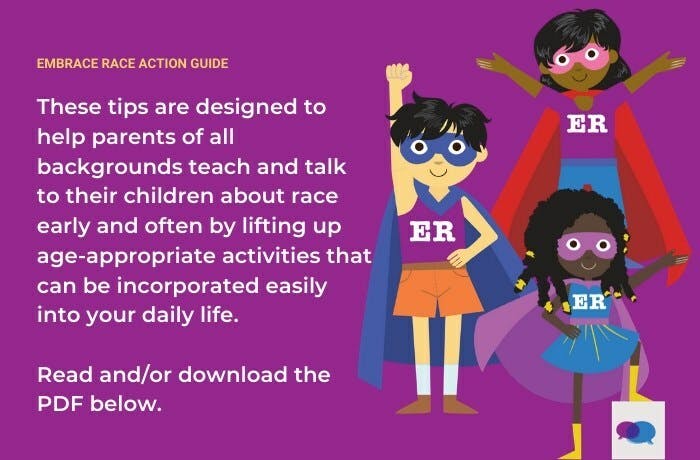10 tips for teaching and talking to kids about race
by EmbraceRace with MomsRising

EmbraceRace is a multiracial community dedicated to sharing and developing best practices for raising and caring for kids, all kids, in the context of race. We partnered with MomsRising - a transformative multicultural organization of more than a million members working to increase family economic security and end discrimination against women and mothers - to create these tips for our communities.
They are designed to help parents of all backgrounds talk to and guide their children about race early and often by lifting up age-appropriate activities that can be incorporated easily into your daily life. We hope these tips provide some much needed support for families committed to building tolerance, racial equity, and a social culture where all kids and families can thrive!
1) Start early.
- By 6 months of age babies are noticing racial differences; by age 4, children have begun to show signs of racial bias.
- Let your child know that it’s perfectly okay to notice skin color and talk about race. Start talking about what racial differences mean and don’t mean.
2) Encourage your child.
Encourage your child to ask questions, share observations and experiences, and be respectfully curious about race.
- Expose your child to different cultural opportunities – photographs, films, books, or cultural events, for example – and discuss the experience afterwards.
- You don’t have to be an expert on race to talk with our child. Be honest about what you don’t know and work with your child to find accurate information.
3) Be mindful.
What kids hear from us is less important than what they see us do.
- You are a role model to your child. What you say is important, but what you do - the diversity of your friendship circle, for example - is likely to have a bigger impact.
- If your child doesn’t attend a diverse school, consider enrolling her in aer-school or weekend activities such as sports leagues that are diverse if you’re able. Choose books and toys that include persons of different races and ethnicities. Visit museums with exhibits about a range of cultures and religions.
4) Face and know your own bias.
Let your child see you acknowledge and face your own biases.
- We’re less likely to pass on the biases we identify and work to overcome.
- Give your child an example of a bias, racial or otherwise, that you hold or have held. Share with your child things you do to confront and overcome that bias.
5) Know and love who you are.
- Talk about the histories and experiences of the racial, ethnic, and cultural groups you and your family identify with. Talk about their contributions and acknowledge the less flattering parts of those histories as well.
- Tell stories about the challenges your family (your child’s parents, aunts and uncles, grandparents and great grandparents, others) has faced and overcome.
6) Develop racial cultural literacy.
Develop racial cultural literacy by learning about and respecting others.
- Study and talk about the histories and experiences of groups we call African Americans, Latinos, Asian Americans, Native Americans, and whites, among others.
- Be sure your child understands that every racial and ethnic group includes people who believe different things and behave in different ways . There is as much diversity within racial groups as across them.
7) Be honest.
Be honest with your child, in age-appropriate ways, about bigotry and oppression.
- Children are amazing at noticing patterns, including racial patterns (who lives in their neighborhood versus their friends' neighborhoods, for example). Help them make sense of those patterns, and recognize that bigotry and oppression are sometimes a big part of those explanations.
- Be sure your child knows that the struggle for racial fairness is still happening and that your family can take part in that struggle.
8) Tell stories.
"Lift up the freedom fighters ": Tell stories of resistance and resilience.
- Every big story of racial oppression is also a story about people fighting back and "speaking truth to power." Teach your child those parts of the story too.
- Include women, children and young adults among the "freedom fighters" in the stories you tell. A story about racial struggle in which all the heroes are men wrongly leaves many people out.
9) Be active.
Be active - don't be a "bystander" on race.
- Help your child understand what it means to be, and how to be, a change agent.
- Whenever possible, connect the conversations you're having to the change you and your child want to see, and to ways to bring about that change .
10) Plan for a marathon, not a sprint.
- It's okay to say, "I'm not sure" or "Let's come back to that later, okay?" But then do come back to it.
- Make race talks with your child routine. Race is a topic you should plan to revisit again and again in many different ways overtime.
Get Insights In your Inbox
Join the EmbraceRace community! You will receive the newsletter with our latest on race & kids, including upcoming events and opportunities, resources, community news and curated links.
Subscribe


